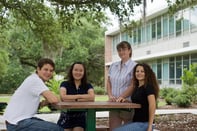Published on
The Importance Of Community Resources For The Non-Traditional Student

Those of us who have spent any amount of time working with non-traditional students know that they often come to us with the deck already stacked against them in a variety of ways: some are extremely low income, some have been out of school for years, and some never even finished high school. Most are trying to balance school with other responsibilities like a full-time job, a family, or other obligations, and many are combating several obstacles at once. So how can we, as education professionals, help them to succeed? For me, the answer lies in community resources.
At my school in the heart of the Midwest, our student demographic is primarily white females who are very low-income, and whose median age range is 25-45 years old. Most have children, many are single mothers, and I would be hard-pressed to find one who would say she has sailed through her educational journey with ease. Students come to my office on a daily basis seeking help with transportation costs, childcare, domestic violence, hunger, and even coats, clothes, and shoes for their children. Most of them pay tuition and fees with student loans, but they struggle to cover everyday expenses and keep their families afloat until they graduate. They have already cut their household expenses to the bone, canceling cable, internet, and home phone, stretching the pantry staples to the last crumb, even shutting off the gas as soon as the temperature inches above freezing. Yet despite these sacrifices, they still struggle to make ends meet. Kids get sick, the car breaks down, unemployment benefits end, the ex-boyfriend stops paying child support, and they find themselves at a crossroads: quit school and perpetuate their problems, or persist in their educational goals, and take a huge risk for the chance to build a better life. That’s where community resources come in.
One of my first tasks as a brand new Student Services Coordinator at my current school was to compile a list of available resources in the community that might help our students with the various obstacles they face on their path to a new future. Over the course of about a year, the compilation that began as a loose file folder of miscellaneous pamphlets, fliers, and business cards has grown to occupy two oversized binders and an extensive digital database. I maintain information about services and agencies local to the school, in the neighboring metropolitan area, and in several surrounding cities and counties. It has been a labor of love, ongoing and ever-changing, but it has also helped countless students to stay in school when they were ready to give up.
But these community resources are by no means a magic bullet for retention, as keeping our students in school and helping them be successful here is often a beast with many heads. For example, many of our students who received food stamps before starting school suddenly find themselves ineligible once they become a college student. Though the rule was originally put in place to prevent more traditional students from taking advantage of aid they really didn’t need, it often puts an added and unexpected strain on the finances of non-traditional students who are already struggling.
Sometimes the agencies that provide resources don’t follow through with the assistance they have offered. When Tammy, a regular visitor to my office, came to me beaten black and blue by her boyfriend, I helped her register for a service provided by the county jail that would notify her when he was released from custody. When it failed to do so, he returned to her house and beat her so badly that she had to be hospitalized.
On the other hand, community resources also helped Tammy remove herself from that situation and become the happy and successful woman she is today. After the second incident of abuse, I was able to connect her with legal assistance that would help make sure her abuser went back to jail and stayed there. A local domestic violence agency gave her and her daughter a place to stay until they could make a permanent move, and once they moved, a church in her area helped her with food, clothing, and household supplies. A state agency helped her find affordable childcare and therapeutic services for her daughter, who is autistic, and a special project on our campus helped her discover her true talent and passion: writing. Tammy is now weeks away from finishing her associate’s degree with us, and has already been offered a job at her externship site. Once she graduates, she plans to take a free summer course through a local community center to prepare for the SAT, and eventually wants to pursue a Bachelor’s degree in a field that will allow her to do a lot of writing.
In terms of the retention and success of non-traditional students, the triumph or failure of community resources in situations like Tammy’s often has as much to do with the individual student and his or her situation as the viability and validity of the resource itself. Students who live in rural or otherwise underserved areas are often at an added disadvantage, as many community resources such as food pantries, plasma centers, and emergency shelters are restricted to the residents of certain postal codes, townships, or counties.
In addition, the student’s own personal attitude about using these resources is key: in the majority of cases, the student must contact the resource independently in order to access its services, and many students are too overwhelmed, too proud, or too entrenched in a culture of entitlement to put forth the kind of effort required to ameliorate their needs. It is not uncommon for a student to come to my office seeking transportation assistance, only to storm out angrily when I offer them phone numbers and websites instead of a gas card. Equally common, however, are students who surprise me with a big hug and joyful tears as they tell me how a resource I gave them is going to help them get through a difficult time and stay in school. It is these instances that bolster my faith in the community and in my students, and bolster my students’ confidence that they are the strong, independent people we push them to be.
And while community resources alone can never be the sole tool in my belt, they can, and do, help adult students learn to help themselves.
Author Perspective: Administrator



